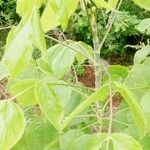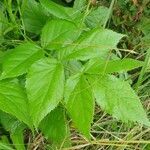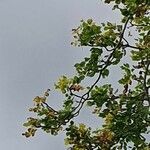Glabrous small tree (rarely a bush), 2-10(-12) m tall, usually straggling and untidy with an irregularly spreading crown; trunk with soft, sappy, pale yellow wood and thick, corky grey-brown bark with papery peel and a green slash. Leaves clustered at the tip of younger twigs and more scattered along some old wood, imparipinnate with 3-4 pairs of leaflets, narrowly or broadly oblong in outline, up to ±45 x 25 cm; leaflets broadly lanceolate to broadly ovate or almost round, the terminal similar to the laterals, ±2-14 x 1.25-8 cm, acuminate, ± abruptly narrowed to a sessile or shortly (to ±6 mm) petiolulate base, regularly serrate with the teeth terminating in a fine bristly arista up to 3 mm long, shorter aristae frequently also present between the teeth; sheaths broad, pale-and sometimes lacerate-margined, ±6-10 mm, abruptly narrowed to the petiole, the base of the sheaths of the upper (clustered) leaves ± surrounding the twig and visible on previous years’ growth as circumferential scars; petiole ±6-15 cm. Flowers usually appearing before (sometimes with) the leaves; flowering branchlets in clusters of mostly ±6-11 at the tips of young twigs, ±6-15 cm long, each branchlet usually with a pair of broad scarious bracts above the middle, from the axils of each of which may arise lateral (generally male) umbels; umbels polygamous, some compound inflorescences entirely bisexual and fertile, or all male, or the central bisexual and the outer male; peduncles ±1.5-10 cm; rays 10-25(-40), glabrous, (1.25-)2.25-8 cm; involucre of 7-8 reflexed, lanceolate bracts ±3-5 mm long; partial umbels 10-50-flowered, pedicels 4-9 mm.; involucel of 3-5 lanceolate-oblong to linear bracteoles 1-2 mm long. Calyx-teeth broadly deltoid, acute, ±0.5 mm. Petals creamy to yellow, roundish, ±1-1.5 mm. Fruit compressed-obpyriform, 8-15 x 5-8 mm, pale-stramineous to whitish at maturity, broadly and shallowly emarginate at the apex; stylopodia almost obsolete, disk broad, immersed in the fruit apex when ripe; styles 1-1.5 mm, divergent, rather slender, exceeding the apical notch.
Glabrous small tree (rarely a bush), 2-10(-12) m tall, usually straggling and untidy with an irregularly spreading crown; trunk with soft, sappy, pale yellow wood and thick, corky grey-brown bark with papery peel and a green slash. Leaves clustered at the tip of younger twigs and more scattered along some old wood, imparipinnate with 3-4 pairs of leaflets, narrowly or broadly oblong in oudine, up to ±45 x 25 cm; leaflets broadly lanceolate to broadly ovate or almost round, the terminal similar to the laterals, ±2-14 x 1.25-8 cm, acuminate, ± abrupdy narrowed to a sessile or shortly (to ±6 mm) petiolulate base, regularly serrate with the teeth terminating in a fine bristly arista up to 3 mm long, shorter aristae frequendy also present between the teeth; sheaths broad, pale-and sometimes lacerate-margined, ±6-10 mm, abrupdy narrowed to the petiole, the base of the sheaths of the upper (clustered) leaves ± surrounding the twig and visible on previous years' growth as circumferential scars; petiole ±6-15 cm Flowers usually appearing before (sometimes with) the leaves; flowering branchlets in clusters of mostly ±6-11 at the tips of young twigs, ±6-15 cm long, each branchlet usually with a pair of broad scarious bracts above the middle, from the axils of each of which may arise lateral (generally male) umbels; umbels polygamous, some compound inflorescences entirely male and fertile, or all male, or the central male and the outer female; peduncles ±1.5-10 cm; rays 10-25(-40), glabrous, (1.25-)2.25-8 cm; involucre of 7-8 reflexed, lanceolate bracts ±3-5 mm long; partial umbels 10-50-flowered, pedicels 4-9 mm; involucel of 3-5 lanceolate-oblong to linear bracteoles 1-2 mm long. Calyx-teeth broadly deltoid, acute, ±0.5 mm Petals creamy to yellow, roundish, ±1-1.5 mm Fruit compressed-obpyriform, 8-15 x 5-8 mm, pale-stramineous to whitish at maturity, broadly and shallowly emarginate at the apex; stylopodia almost obsolete, disk broad, immersed in the fruit apex when ripe; styles 1-1.5 mm, divergent, rather slender, exceeding the apical notch.
Inflorescence of 7–10 compound umbels on robust peduncles 6–17 cm. long, densely crowded at the apex of branches, with short membranous basal bracts. Peduncles often with up to 3 smaller lateral umbels in addition to the central one, and these may be composed of male flowers only. Main umbels with 8–15 robust rays of 3–4·5 cm. long. Bracts few, small, almost obsolete. Partial umbels with numerous fine rays of c. 5–7 mm. long; bracteoles few, membranous, very small and inconspicuous.
Leaflets 3·5–12 × 2–7 cm., in 3–4 pairs plus a terminal one, lanceolate to narrowly lanceolate, rarely nearly circular, borne on short petiolules or sessile. Apex narrowly acute with a prolonged stiff mucro, base rounded to subcuneate; margin regularly serrate, the tips of the teeth produced as long stiff bristles (similar bristles are sometimes also found on the side of the teeth).
Small deciduous tree or shrub, 2-10 m high. Leaves simply pinnate, densely crowded at end of shoots; leaflets ovate or lanceolate to narrowly lanceolate; apex acute with prolonged stiff mucro; margin regularly serrate, tips of teeth produced as long stiff bristles. Flowers greenish white to yellow or purplish.
Fruit 12–13 × 6–8 mm., usually narrowly obovate, very strongly dorsally compressed, with well-developed lateral wings as wide as the seed-containing part. Mericarps with 3 distinct dorsal ribs which may occasionally be slightly winged.
Small glabrous deciduous tree or shrub, from c. 2–10 m. high, with ascending branches; bark grey formed with a small rectangular pattern; upper stem corky, pale grey; leaves normally absent at flowering and fruiting times.
Flowers with greenish-white to yellow or purplish petals; calyx teeth obsolete; stylopodium depressed, forming a disk 2–2·5 mm. in diameter in fruit; styles 1·5 mm. long, divergent, short, slightly clubbed at the apex.
Carpophore entire lying in a groove in the otherwise flat inner surface of the mericarp.
Leaves 15–40 cm. long, simply pinnate, densely crowded at the ends of the shoots.
Compound umbels of small, white flowers
Vittae rudimentary to obsolete.
A small, soft-wooded tree
A herb.




